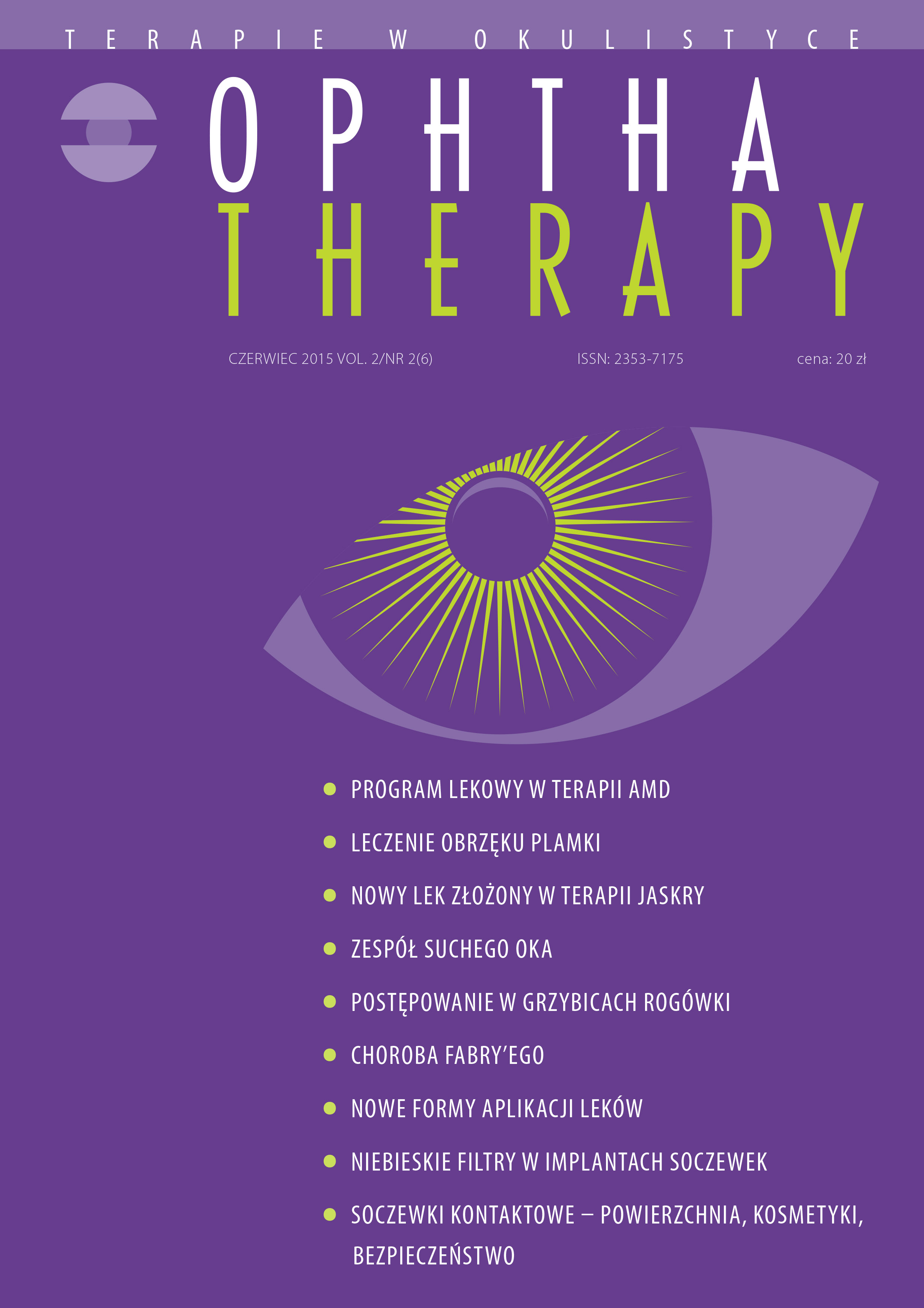Impact of cosmetic products on ocular surface and contact lens material properties
Main Article Content
Abstract
Cosmetic products applied external to the ocular surface contain a range of substances that are potentially irritant. Among these ingredients there may be mentioned waxes and oils, pigments, fillers and preservatives. Cosmetics migration into the tear film and ocular surface can have influence on eye comfort and health. To date, mechanisms that induce allergic reactions or tear film instability and epithelial damage are quite well known. However, there is still lack of information on interactions of cosmetic products with contact lens materials. The aim of this article is to bring existing knowledge on influence of cosmetics on irritant and allergic reactions due to their use near to ocular tissues of anterior eye.
Downloads
Article Details

This work is licensed under a Creative Commons Attribution-NonCommercial-NoDerivatives 4.0 International License.
Copyright: © Medical Education sp. z o.o. License allowing third parties to copy and redistribute the material in any medium or format and to remix, transform, and build upon the material, provided the original work is properly cited and states its license.
Address reprint requests to: Medical Education, Marcin Kuźma (marcin.kuzma@mededu.pl)
References
2. Nigam PK. Adverse reactions to cosmetics and methods of testing. Indian J Venerol Leprol. 2009; 75: 10-9.
3. Hamilton T, de Gannes G. Allergic contact dermatitis to preservatives and fragrances in cosmetics. Skin Therapy Letter. 2011; 16(4): 1-4.
4. Ng A, Evans K, North R et al. Eye cosmetic usage and associated ocular comfort. Ophthalmic Physiol Opt. 2012; 32(6): 501-7.
5. Marren SE. Contact lens wear, use of eye cosmetics and meibomian gland dysfunction. Opt Vis Sci. 1994; 71(1): 60-2.
6. Hunter M, Bhola R, Yappert MC et al. Pilot study of the influence of eyeliner cosmetics on the molecular structure of human meibum. Ophth Res. 2015; 53: 131-5.
7. Malik A, Claoué C. Transport and interaction of cosmetic product material within the ocular surface: Beauty and beastly symptoms of toxic tears. Cont Lens Anterior Eye. 2012; 35: 247-59.
8. Coroneo MT, Rosenberg ML, Cheung LM et al. Ocular effects of cosmetic products and procedures. Ocul Surf. 2006; 4(2): 94-100.
9. Gao Y, Kanengiser BE. Categorical evaluation of the ocular irritancy of cosmetic and consumer products by human ocular instillation procedures. J Cosmet Sci. 2004; 55: 317-25.
10. Kari O, Saari M. Diagnostics and new developments in the treatment of ocular allergies. Curr Allergy Asthma Rep. 2012; 12: 232-9.
11. Chowdhury MM. Allergic contact dermatitis from prime yellow carnauba wax and coathylene in mascara. Contact Dermatitis. 2002; 46(4): 244.
12. Murube J. Ocular cosmetics in modern times. Ocul Surf. 2013; 11(2): 60-4.
13. Hepp NM, Mindak WR, Gasper JW et al. Survey of cosmetics for arsenic, cadmium, chromium, cobalt, lead, mercury, and nickel content. J Cosmet Sci. 2014; 65: 125-15.
14. Borowska S, Brzóska MM. Metals in cosmetics: implications for human health. Appl Toxicol. 2015; 35: 551-72.
15. Vogel TA, Coenraads PJ, Schuttelaar ML. Allergic contact dermatitis presenting as severe and centrofacial oedema after dyeing of eyelashes. Contact Dermatitis. 2014; 71: 304-6.
16. de Groot AC. Side-effects of henna and semi-permanent ‘black henna’ tattoos: a full rewiev. Contact Dermatitis. 2013; 69: 1-25.
17. Noecker R. Effects of common ophthalmic preservatives on ocular health. Adv Ther. 2001; 18(5): 205-15.
18. Linda B, Sedlewicz BS. Cosmetic Preservatives: Friend or foe? Skinmed. 2005; 4(2): 98-100.
19. Baudouin C, Labbé A, Liang H et al. Preservatives in eyedrops: The good, the bad and the ugly. Prog Retin Eye Res. 2010; 29: 312-34.
20. Lee S, Mian F, Lee HJ et al. Thimerosal induces oxidative stress in HeLa S epithelial cells. Environ Toxicol and Pharm. 2006; 22: 194-9.
21. Hudson C. Impact of cosmetics on the ocular surface and contact lens wear. Online: http://www.optometry.co.uk/uploads/exams/articles/cet_30_sept_2011_hudson.pdf. (Access: 8.05.2015 r.).
22. Hickson-Curran S, Spyridon M, Young G. The use of daily disposable lenses in problematic reusable contact lens wearers. Cont Lens Anterior Eye. 2014; 37: 285-91.
23. Hayes VY, Schnider CM, Veys J. An evaluation of 1-day disposable contact lens wear in a population of allergy sufferers. Cont Lens Anterior Eye. 2003; 26(2): 85-93.
24. Jones L, Senchyna M, Glasier MA et al. Lysozyme and lipid deposition on silicone hydrogel contact lens materials. Eye Contact Lens. 2003; 29(1S): S75-9.
25. Srinivasan S, Otchere H, Yu M et al. Impact of Cosmetics on the Surface Properties of Silicone Hydrogel Contact Lenses. Eye Contact Lens. 2015 [epub ahead of print].
26. Zhao Z, Carnt NA, Aliwarga Y et al. Care regimen and lens material influence on silicone-hydrogel contact lens deposition. Opt Vis Sci. 2009; 86(3): 251-9.

